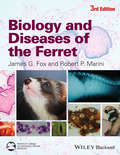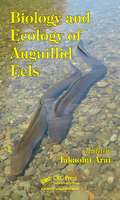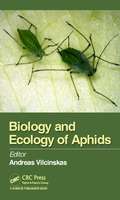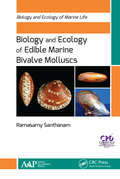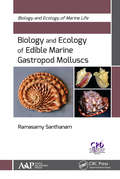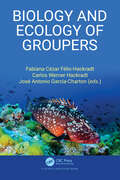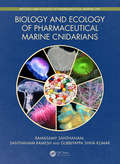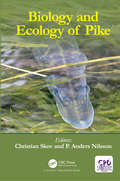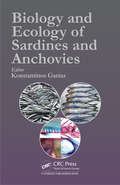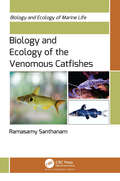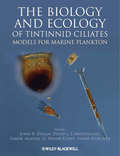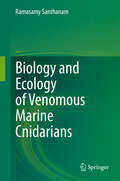- Table View
- List View
Biology and Diseases of the Ferret
by James G. Fox Robert P. MariniBiology and Diseases of the Ferret, Third Edition has been thoroughly revised and updated to provide a current, comprehensive reference on the ferret. Encyclopedic in scope, it is the only book to focus on the characteristics that make the ferret an important research animal, with detailed information on conditions, procedures, and treatments. Offering basic information on biology, husbandry, clinical medicine, and surgery, as well as unique information on the use of ferrets in biomedical research, Biology and Diseases of the Ferret is an essential resource for investigators using ferrets in the laboratory and for companion animal and comparative medicine veterinarians. The Third Edition adds ten completely new chapters, covering regulatory considerations, black-footed ferret recovery, diseases of the cardiovascular system, viral respiratory disease research, morbillivirus research, genetic engineering, hearing and auditory function, vision and neuroplasticity research, nausea and vomiting research, and lung carcinogenesis research. Additionally, the anesthesia, surgery, and biomethodology chapter has been subdivided into three and thoroughly expanded. The book also highlights the ferret genome project, along with the emerging technology of genetically engineered ferrets, which is of particular importance to the future of the ferret as an animal model in research and will allow the investigation of diseases and their genetic basis in a small, easily maintained, non-rodent species.
Biology and Diseases of the Ferret
by James G. Fox Robert P. MariniBiology and Diseases of the Ferret, Third Edition has been thoroughly revised and updated to provide a current, comprehensive reference on the ferret. Encyclopedic in scope, it is the only book to focus on the characteristics that make the ferret an important research animal, with detailed information on conditions, procedures, and treatments. Offering basic information on biology, husbandry, clinical medicine, and surgery, as well as unique information on the use of ferrets in biomedical research, Biology and Diseases of the Ferret is an essential resource for investigators using ferrets in the laboratory and for companion animal and comparative medicine veterinarians. The Third Edition adds ten completely new chapters, covering regulatory considerations, black-footed ferret recovery, diseases of the cardiovascular system, viral respiratory disease research, morbillivirus research, genetic engineering, hearing and auditory function, vision and neuroplasticity research, nausea and vomiting research, and lung carcinogenesis research. Additionally, the anesthesia, surgery, and biomethodology chapter has been subdivided into three and thoroughly expanded. The book also highlights the ferret genome project, along with the emerging technology of genetically engineered ferrets, which is of particular importance to the future of the ferret as an animal model in research and will allow the investigation of diseases and their genetic basis in a small, easily maintained, non-rodent species.
Biology and Ecology of Anguillid Eels
by Takaomi AraiAnguillid eels have fascinated biologists for centuries due to their spectacular long-distance migrations between freshwater habitats and their spawning areas far out in the ocean. This book provides a long overdue update on the biology and ecology of anguillid eels and features comprehensive coverage of the key features of the genus Anguilla. It c
Biology and Ecology of Antarctic Krill (Advances in Polar Ecology #1)
by Volker SiegelThis book gives a unique insight into the current knowledge of krill population dynamics including distribution, biomass, production, recruitment, growth and mortality rates. Detailed analysis is provided on food and feeding, reproduction and krill behaviour. The volume provides an overview on the aspects of natural challenges to the species, which involve predation, parasites and the commercial exploitation of the resource and its management. A chapter on genetics shows the results of population subdivision and summarizes recent work on sequencing transcriptomes for studying gene function as part of the physiology of live krill. The focus of Chapter 4 is on physiological functions such as biochemical composition, metabolic activity and growth change with ontogeny and season; and will demonstrate which environmental factors are the main drivers for variability. Further discussed in this chapter are the bottle necks which occur in the annual life cycle of krill, and the mechanisms krill have adapted to cope with severe environmental condition.
Biology and Ecology of Aphids
by Andreas VilcinskasMost people know of aphids as garden pests, infesting the soft green tissues of plants in vast numbers and killing them by sucking out the sap. Indeed, among the 4000 or so known species of aphids about 250 are pests, and in temperate regions several are economically important agricultural pests that damage crops directly during feeding or act as v
Biology and Ecology of Earthworms
by Clive A. Edwards Norman Q. AranconBiology and Ecology of Earthworms is established as a key valuable text for students of agriculture, soil science, and soil invertebrate zoology and ecology. This is the 4th Edition of the popular textbook which reviews all aspects of earthworm biology and ecology. The book has been fully revised and updated throughout. Particular changes include: new treatments of earthworm taxonomy, diversity, migration and geographical distribution; interactions between earthworms and other soil organisms, especially microorganisms and soil-borne pests and diseases; as well as the importance of earthworms in organic waste management.
Biology and Ecology of Edible Marine Bivalve Molluscs (Biology and Ecology of Marine Life)
by Ramasamy SanthanamThis comprehensive volume provides a plethora of first-hand information on the diversity, biology, and ecology of edible marine bivalve molluscs. It covers the biology of edible marine bivalves; profiles about 180 species, providing information on their habitat, distribution, morphology, food and feeding, reproduction, conservation status, etc.; discusses their nutritional values; examines their pharmaceutical value; and looks at their diseases and parasites. This abundance of knowledge is presented in an easy-to-read style with informative illustrations. Marine bivalve molluscs play important roles in the marine ecosystems by filtering water and serving as habitat and prey for a variety of sea life. This diverse group of species, estimated at around 9,200, inhabits virtually the entire world’s oceans, from the balmy tropics to the sub-zero Arctic, and from deep oceans to sandy and rocky shorelines. Among the marine bivalves, a total of 180 species (including mussels, oysters, scallops, cockles, and clams) have long been a part of the diet of coastal human populations. Many species of marine bivalves are also commercially important for other purposes, such as pearls and shells for jewelry and decoration. The volume, part of the Biology and Ecology of Marine Life book series, will be of great use to students and researchers in fisheries science, marine biology, aquatic biology, and zoology.
Biology and Ecology of Edible Marine Bivalve Molluscs (Biology and Ecology of Marine Life)
by Ramasamy SanthanamThis comprehensive volume provides a plethora of first-hand information on the diversity, biology, and ecology of edible marine bivalve molluscs. It covers the biology of edible marine bivalves; profiles about 180 species, providing information on their habitat, distribution, morphology, food and feeding, reproduction, conservation status, etc.; discusses their nutritional values; examines their pharmaceutical value; and looks at their diseases and parasites. This abundance of knowledge is presented in an easy-to-read style with informative illustrations. Marine bivalve molluscs play important roles in the marine ecosystems by filtering water and serving as habitat and prey for a variety of sea life. This diverse group of species, estimated at around 9,200, inhabits virtually the entire world’s oceans, from the balmy tropics to the sub-zero Arctic, and from deep oceans to sandy and rocky shorelines. Among the marine bivalves, a total of 180 species (including mussels, oysters, scallops, cockles, and clams) have long been a part of the diet of coastal human populations. Many species of marine bivalves are also commercially important for other purposes, such as pearls and shells for jewelry and decoration. The volume, part of the Biology and Ecology of Marine Life book series, will be of great use to students and researchers in fisheries science, marine biology, aquatic biology, and zoology.
Biology and Ecology of Edible Marine Gastropod Molluscs (Biology and Ecology of Marine Life)
by Ramasamy SanthanamThis comprehensive volume focuses exclusively on sea snails (or gastropods), which are popular food items and occupy an important role in the commercial shell craft industry. Familiar examples include conchs (highly sought after due to their mild flavor) and escargot, abalone, and periwinkle snails. This book covers the profile (habitat, distribution, morphology, food and feeding, reproduction, conservation status, etc.) of about 180 species of commercial edible marine gastropod molluscs as well as their nutritional values, commercial importance, and pharmaceutical value. Also included is information on their prevalent diseases and parasites. The informative descriptions are presented in an easy-to-read style with neat illustrations.
Biology and Ecology of Edible Marine Gastropod Molluscs (Biology and Ecology of Marine Life)
by Ramasamy SanthanamThis comprehensive volume focuses exclusively on sea snails (or gastropods), which are popular food items and occupy an important role in the commercial shell craft industry. Familiar examples include conchs (highly sought after due to their mild flavor) and escargot, abalone, and periwinkle snails. This book covers the profile (habitat, distribution, morphology, food and feeding, reproduction, conservation status, etc.) of about 180 species of commercial edible marine gastropod molluscs as well as their nutritional values, commercial importance, and pharmaceutical value. Also included is information on their prevalent diseases and parasites. The informative descriptions are presented in an easy-to-read style with neat illustrations.
Biology and Ecology of Groupers
by Fabiana Cézar Félix-HackradtGroupers are fascinating charismatic fishes commonly found in reef habitats around the world that sustain a global multimillionaire fishery. They are an important top predator species and therefore of paramount ecological importance for reef systems' resilience. The book, Biology and Ecology of Groupers is an up-to-date review of the main bio-ecological topics involving worldwide groupers species oriented to the academic community and managers. It covers aspects of classification and phylogenetic relationships, geographical distribution, and life history related characteristics (Section I), including the major threats of groupers populations, case studies of successful management and comments about the future of groupers in our changing world (Section II).
Biology and Ecology of Groupers
by Fabiana Cézar Félix-Hackradt Carlos Werner Hackradt José Antonio García-ChartonGroupers are fascinating charismatic fishes commonly found in reef habitats around the world that sustain a global multimillionaire fishery. They are an important top predator species and therefore of paramount ecological importance for reef systems' resilience. The book, Biology and Ecology of Groupers is an up-to-date review of the main bio-ecological topics involving worldwide groupers species oriented to the academic community and managers. It covers aspects of classification and phylogenetic relationships, geographical distribution, and life history related characteristics (Section I), including the major threats of groupers populations, case studies of successful management and comments about the future of groupers in our changing world (Section II).
Biology and Ecology of Pharmaceutical Marine Cnidarians (Biology and Ecology of Marine Life)
by Ramasamy Santhanam Santhanam Ramesh Gubbiyappa Shiva KumarThe first comprehensive book on the biology and ecology of pharmaceutical cnidarians, answering a need for more knowledge about the identification, biology, natural products and bioactivities of these living resources. Contributed by scientists of both marine biology and pharmacy disciplines. Identifies the correct marine species, shows the ecological parameters of that species, and explores its biological values with particular attention to primary and secondary metabolites or bioactive constituents. A useful supplementary text on Marine Biology and Pharmacology courses. Nearly 200 illustrations are produced in full color, providing a high-quality reference. This book provides the taxonomy, common name, global distribution, habitat, diagnostic features, and pharmaceutical compounds (along with their activities) of 200 species of marine cnidarians along with nearly 200 detailed illustrations in glorious color. The phylum Cnidaria (formerly Coelenterata) is a large, diverse, and ecologically important group of marine invertebrates which make up 40 percent of the biomass of the oceans. Marine invertebrates are the richest source of marine natural products with potential applications in the pharmaceutical and medical sectors, and it has been reported that over 3000 bioactive compounds have been described from this phylum alone, mostly in the last decade.
Biology and Ecology of Pharmaceutical Marine Cnidarians (Biology and Ecology of Marine Life)
by Ramasamy Santhanam Santhanam Ramesh Gubbiyappa Shiva KumarThe first comprehensive book on the biology and ecology of pharmaceutical cnidarians, answering a need for more knowledge about the identification, biology, natural products and bioactivities of these living resources. Contributed by scientists of both marine biology and pharmacy disciplines. Identifies the correct marine species, shows the ecological parameters of that species, and explores its biological values with particular attention to primary and secondary metabolites or bioactive constituents. A useful supplementary text on Marine Biology and Pharmacology courses. Nearly 200 illustrations are produced in full color, providing a high-quality reference. This book provides the taxonomy, common name, global distribution, habitat, diagnostic features, and pharmaceutical compounds (along with their activities) of 200 species of marine cnidarians along with nearly 200 detailed illustrations in glorious color. The phylum Cnidaria (formerly Coelenterata) is a large, diverse, and ecologically important group of marine invertebrates which make up 40 percent of the biomass of the oceans. Marine invertebrates are the richest source of marine natural products with potential applications in the pharmaceutical and medical sectors, and it has been reported that over 3000 bioactive compounds have been described from this phylum alone, mostly in the last decade.
Biology and Ecology of Pharmaceutical Marine Life: Echinoderms (Biology and Ecology of Marine Life)
by Ramasamy Santhanam Santhanam Ramesh Sheba Rani Nakka DavidThe first comprehensive book on the biology and ecology of pharmaceutical echinoderms. Contributed by scientists of both marine biology and pharmacy disciplines. All reported echinoderm species producing secondary metabolites are dealt with. Previously known only as nutritional invertebrates, the contribution of the echinoderms as sources of secondary metabolites for therapeutic compounds is a topic ripe for exploration. All 200+ images are produced in full color. This book provides the taxonomy, common name, global distribution, habitat, diagnostic features and pharmaceutical compounds (along with their activities) of 150 species of ecinoderms along with over 200 detailed illustrations in glorious color. Among the biota of marine habitats, the echinoderms, which include sea stars (starfish), brittle stars and basket stars, sea urchins and sand dollars, sea cucumbers, and sea lilies or feather stars, are known for their importance as promising sources of bioactive compounds for development of pharmaceuticals. Their potential therapeutic applications have been growing rapidly in the treatment of many diseases.
Biology and Ecology of Pharmaceutical Marine Life: Echinoderms (Biology and Ecology of Marine Life)
by Ramasamy Santhanam Santhanam Ramesh Sheba Rani Nakka DavidThe first comprehensive book on the biology and ecology of pharmaceutical echinoderms. Contributed by scientists of both marine biology and pharmacy disciplines. All reported echinoderm species producing secondary metabolites are dealt with. Previously known only as nutritional invertebrates, the contribution of the echinoderms as sources of secondary metabolites for therapeutic compounds is a topic ripe for exploration. All 200+ images are produced in full color. This book provides the taxonomy, common name, global distribution, habitat, diagnostic features and pharmaceutical compounds (along with their activities) of 150 species of ecinoderms along with over 200 detailed illustrations in glorious color. Among the biota of marine habitats, the echinoderms, which include sea stars (starfish), brittle stars and basket stars, sea urchins and sand dollars, sea cucumbers, and sea lilies or feather stars, are known for their importance as promising sources of bioactive compounds for development of pharmaceuticals. Their potential therapeutic applications have been growing rapidly in the treatment of many diseases.
Biology and Ecology of Pike
by Anders Nilsson P. Anders NilssonThis book sets out to bridge the order scales among pike researchers, populations, communities, management, and fisheries. It emphasizes the progress of pike research during the last two decades, during which the order-bridging approach emerged. This framework underpins the text and the message, to convey its importance to pike research and to fish research in general. In addition, a considerable part of the book is devoted to management implications and highlights aspects of human dimensions in recreational fisheries.
Biology and Ecology of Pike
by Christian Skov P. Anders NilssonThis book sets out to bridge the order scales among pike researchers, populations, communities, management, and fisheries. It emphasizes the progress of pike research during the last two decades, during which the order-bridging approach emerged. This framework underpins the text and the message, to convey its importance to pike research and to fish research in general. In addition, a considerable part of the book is devoted to management implications and highlights aspects of human dimensions in recreational fisheries.
Biology and Ecology of Sardines and Anchovies
by Konstantinos GaniasApart from being commercially and socially significant, anchovies and sardines populations occupy crucial positions in the oceans' ecosystems. Low in the food chain, clupeoids tend towards abundance, as if their purpose in life was to be eaten and fuel the upper levels of marine trophic chains. The present book covers a broad spectrum of topics on
Biology and Ecology of the Brown and Sea Trout: State of the Art and Research Themes (pdf)
by J. L. Bagliniere Gerard MaisseBiology and Ecology of the Venomous Catfishes (Biology and Ecology of Marine Life)
by Ramasamy SanthanamHere is a first-of-its-kind volume on the biology and ecology of venomous and traumatogenic freshwater and marine catfishes. This comprehensive volume first provides an introduction to venomous catfish families and then goes on to describe and explain their diversity, species, characteristics, geographical distribution, venomous symptoms, ecology, and the pharmaceutical value of catfish venoms.Catfish form an important group of fishes with many different roles, including as food, as ornamental fishes, and for sport fishing. Catfish are found to be distributed worldwide but are most abundantly distributed in the tropics of Asia, Africa, and South America. Like jellyfish, scorpions, and snakes, several species of catfish have been reported to be venomous with their painful stings. The major groups of persons at risk for catfish envenomation are fishermen and water sports participants. It is estimated that 1625 species of catfish are venomous although this has been studied for only 158 species. While some species of catfish cause mild envenomation, several species have been reported to cause severe envenomation associated with secondary bacterial infections. The symptoms related to catfish envenomation include local intense pain, edema, erythema, paleness, and cutaneous necrosis. Notable species of catfish causing serious envenomations include the Arabian Gulf catfish (Arius thalassinus), Carolina madtom (Noturus furiosus), and Oriental catfish (Plotosus lineatus).Providing extensive information, this volume serves as a text and reference for students and researchers of several disciplines, such as marine biology, fisheries science, and aquatic biology; as a guide for physicians and environmentalists; and as a valuable reference book for marine libraries of colleges and universities.
Biology and Ecology of the Venomous Catfishes (Biology and Ecology of Marine Life)
by Ramasamy SanthanamHere is a first-of-its-kind volume on the biology and ecology of venomous and traumatogenic freshwater and marine catfishes. This comprehensive volume first provides an introduction to venomous catfish families and then goes on to describe and explain their diversity, species, characteristics, geographical distribution, venomous symptoms, ecology, and the pharmaceutical value of catfish venoms.Catfish form an important group of fishes with many different roles, including as food, as ornamental fishes, and for sport fishing. Catfish are found to be distributed worldwide but are most abundantly distributed in the tropics of Asia, Africa, and South America. Like jellyfish, scorpions, and snakes, several species of catfish have been reported to be venomous with their painful stings. The major groups of persons at risk for catfish envenomation are fishermen and water sports participants. It is estimated that 1625 species of catfish are venomous although this has been studied for only 158 species. While some species of catfish cause mild envenomation, several species have been reported to cause severe envenomation associated with secondary bacterial infections. The symptoms related to catfish envenomation include local intense pain, edema, erythema, paleness, and cutaneous necrosis. Notable species of catfish causing serious envenomations include the Arabian Gulf catfish (Arius thalassinus), Carolina madtom (Noturus furiosus), and Oriental catfish (Plotosus lineatus).Providing extensive information, this volume serves as a text and reference for students and researchers of several disciplines, such as marine biology, fisheries science, and aquatic biology; as a guide for physicians and environmentalists; and as a valuable reference book for marine libraries of colleges and universities.
The Biology and Ecology of Tintinnid Ciliates: Models for Marine Plankton
by John R. Dolan David J. S. Montagnes Sabine Agatha D. Wayne Coats Diane K. StoeckerPlanktonic protists both produce and consume most of the primary production in the world ocean. They not only play key roles in the oceans but also represent an astounding amount of diversity: ecological morphological and genetic. However, for most taxa their ecology, morphology, phylogeny and biogeography are either poorly known or appear to be largely unrelated to one another; this hinders our understanding of their biology as well as interpretation of emerging genetic data. Tintinnid ciliates represent a singular exception. Compared to nearly all other groups of planktonic protists, there is a very substantial and relatively detailed literature (both modern and historical) on tintinnids. This volume synthesizes knowledge concerning a wide variety of topics ranging from anatomy and systematics, physiology, behavior, ecology (including ecological roles, predators, parasites, biogeography, and cysts) to fossil history. It will appeal to an audience ranging from advanced undergraduates to researchers in the fields of Oceanography, Marine Biology and Microbial Ecology.
The Biology and Ecology of Tintinnid Ciliates: Models for Marine Plankton
by John R. Dolan David J. S. Montagnes Sabine Agatha D. Wayne Coats Diane K. StoeckerPlanktonic protists both produce and consume most of the primary production in the world ocean. They not only play key roles in the oceans but also represent an astounding amount of diversity: ecological morphological and genetic. However, for most taxa their ecology, morphology, phylogeny and biogeography are either poorly known or appear to be largely unrelated to one another; this hinders our understanding of their biology as well as interpretation of emerging genetic data. Tintinnid ciliates represent a singular exception. Compared to nearly all other groups of planktonic protists, there is a very substantial and relatively detailed literature (both modern and historical) on tintinnids. This volume synthesizes knowledge concerning a wide variety of topics ranging from anatomy and systematics, physiology, behavior, ecology (including ecological roles, predators, parasites, biogeography, and cysts) to fossil history. It will appeal to an audience ranging from advanced undergraduates to researchers in the fields of Oceanography, Marine Biology and Microbial Ecology.
Biology and Ecology of Venomous Marine Cnidarians
by Ramasamy SanthanamSeas and oceans cover 71 % of the earth’s surface and they are home to 80% of all life found on the planet . Among the different components of marine life, the phylum Cnidaria (formerly Coelenterata) has been reported to be responsible for more envenomations than any other marine phylum. It is believed that 2% of its known 11000 species are venomous to humans. Incidents caused by jellyfish are common all around the globe, with serious manifestations and occasional deaths reported in some countries. The Australian box jellyfish, Chironex fleckeri , has been reported to be very dangerous to humans, as contact with its tentacles can provoke immediate cardiovascular collapse and death within minutes. Though other volumes on venomous marine fauna are available, this is the first comprehensive book focusing on venomous marine cnidarians. It is a valuable text-cum-reference resource for researchers, teachers and students of various disciplines, including fisheries science, marine biotechnology and marine biology and for university and college libraries. It is also a useful guide for beachgoers, divers, physicians and environmentalists.
